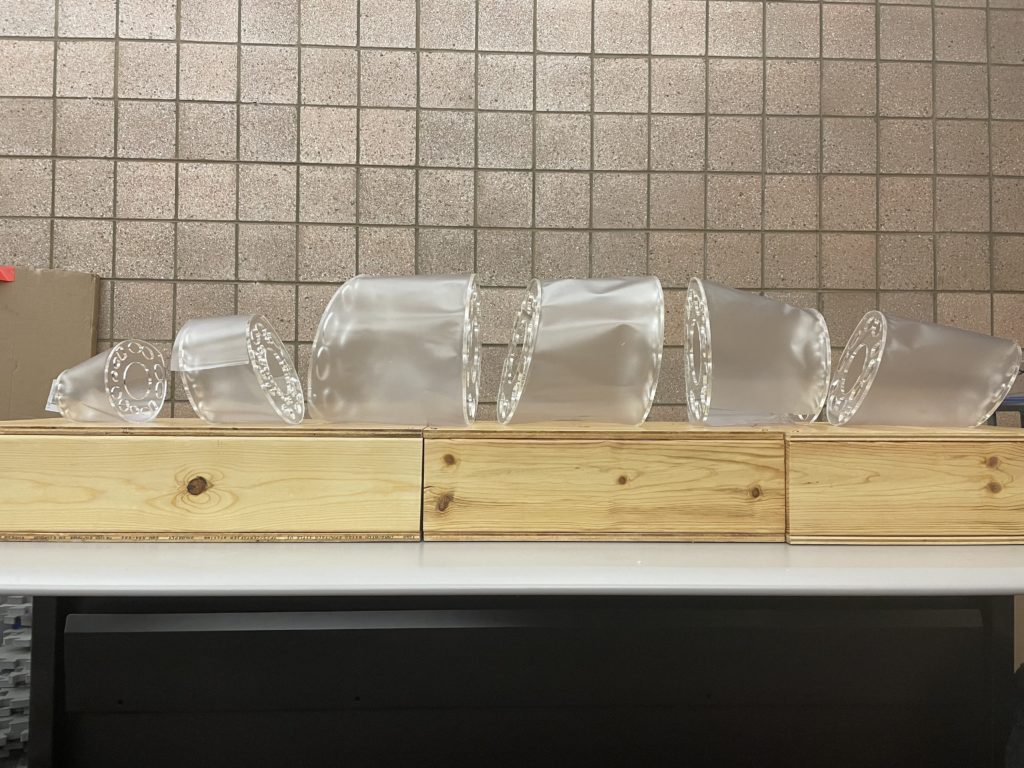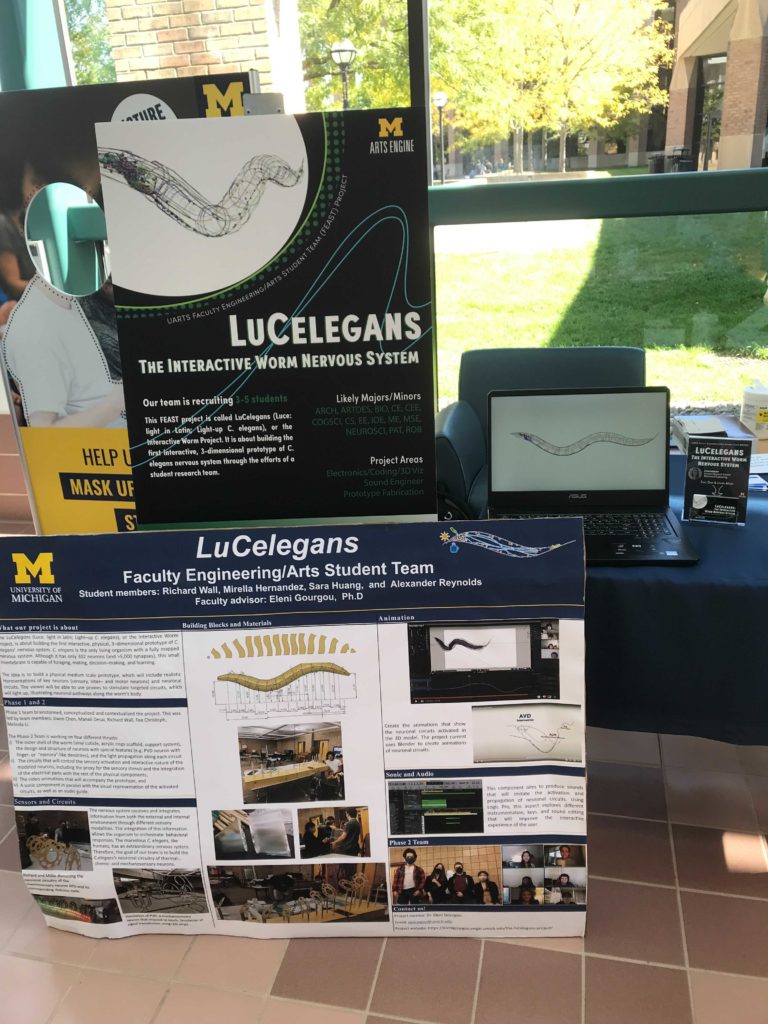The LuCelegans (Luce: light in latin; Light–up C. elegans), or the Interactive Worm Project, is about building the first interactive, physical, 3–dimensional prototype of C. elegans’ nervous system.
C. elegans is the only living organism with a fully mapped nervous system. Although it has only 302 neurons (and >5,000 synapses), this small invertebrate is capable of foraging, mating, decision–making, and learning.
The idea is to build a physical medium scale prototype, which will include realistic representations of key neurons (sensory, inter– and motor neurons) and neuronal circuits. The viewer will be able to use proxies to stimulate targeted circuits, which will light up, illustrating neuronal pathways along the worm’s body.
Phase 1
Phase 1 was supported by ArtsEngine. The Phase 1 Team brainstormed, conceptualized and contextualized the project, and decided on the neurons and neuronal connections that would be included in the first iteration, special attention given to showcase key circuits which control major sensations (chemosensation, mechanosensation, thermosensation) in young adult hermaphrodites. The Team designed and developed the “skeleton” of the prototype, i.e. the scaffold on which the neurons would be mounted, decided the appropriate materials to use to model neurons and special neuronal features, built prototype neurons, and materialized structural elements of the model worm, such as the vinyl cuticle (skin), the acrylic scaffold rings, etc. The Team created also the software and hardware foundation on which we can build the electrical circuits that will control the sensors and interactive neurons.

LuCelegans Phase 1 Team Members:

Richard Wall, junior student in ME and CS, is working on programming and animation. Richard’s main contributions include: Sensors (selection and connectivity), software tools design, electrical circuits design and implementation, neuronal circuits implementation, code writing, Arduino integration, video animations (Blender).
Jiwen Chen, senior, major in Mechanical Engineering (UMich) and Electrical & Computer Engineering (Shanghai Jiao Tong University). Jiwen is interested in building models and prototypes of biological systems and organisms. Some of his many contributions on the project include: Sensors (selection and connectivity), software tools design, electrical circuits design and implementation, neuronal circuits design and implementation, model neurons fabrication, code writing, Arduino and Raspberry Pi integration, neuronal axons features prototyping.
Manali Desai holds a Bachelor’s degree from UoM, with major in BSI and a minor in Art&Design, and is now a MSI grad student. She is an interdisciplinary designer with passions for digital fabrication, interaction design, education and fun shenanigans. Building a giant nematode was a natural course of action. Her key contributions include: Materials studies and research, CAD design (Rhino), body cross section design and fabrication, special neuronal structures design, neuronal circuits design, model neurons material properties, editor of LuCelegans Torsual (aka manual).
Former team members: Melinda Li, ME (sensors research, CAD design, 3D-printed parts conceptualization); Fee Cristoph, Arts&Design & CSE (software design, electrical circuits design and implementation, hardware design, materials studies and research, casing design and fabrication, code writing, logistics coordination, prototyping and conceptualization); Amanda Taylor, Arts&Design and Socio-Anthropology (materials studies and research, CAD design, prototyping).
Phase 2
Phase 2 started in Winter 2021, in the context of ArtsEngine FEAST /MDP Initiative. It will conclude at the end of the Fall 2021 semester.
The Phase 2 Team is working on four different thrusts: i) the outer shell of the worm (vinyl cuticle, acrylic rings scaffold, support system), the design and structure of neurons with special features (e.g. PVD neuron with finger- or “menora”-like dendrites), and the light propagation along each circuit, ii) the circuits that will control the sensory activation and interactive nature of the modeled neurons, including the proxy for the sensory stimuli and the integration of the electrical parts with the rest of the physical components, iii) the video animations that will accompany the prototype, and iv) a sonic component in parallel with the visual representation of the activated circuits, as well as an audio guide. In parallel, the Phase 2 team is working on establishing creative ways to disseminate their progress, so stay tuned for more!
LuCelegans Phase 2 Team Members:
Sara Huang: Sara is a sophomore in LSA majoring in Neuroscience and is on the pre-med track. Her interest lies in bringing together her passions in neuroscience, education, design and the arts all into one project. She is currently working on developing the sonic component and audio guide, animation, and building and materials.
Alexander Reynolds: Alexander is a senior in Biomedical Engineering at the University of Michigan and he is excited for the next stage of his Academic/Professional career. Throughout his education, one lesson has become ever present: the interconnectedness between subject matter across all disciplines. This has been especially true of his experiences this last semester by working together with students of different backgrounds and majors to achieve one central goal.
Jaehong Min: Jaehong is a first-year engineering student, and is working on programming and creating audio for the LuCelegans. Jaehong is interested in the possibilities that electricity and computers hold, and hopes to further these interests by working on the sensors and circuits team within the project. Jaehong is working on the Arduino and Pi integration for the circuits of the LuCelegans. Also, he is interested in how sound can be incorporated into the project. He hopes to explore this by creating a sonic component that will accompany the triggering of the circuits.
Mirella Hernandez Lima: Millie is a graduate student in the Neuroscience Graduate Program. She obtained her Bachelor of Arts in Biopsychology from the California State University San Bernardino. In addition to pursuing a doctoral degree, she enjoys participating in activities that promote interdisciplinary collaboration to advance science.
Richard Wall: Richard was also a Phase 1 Team member! He is currently a junior student in Mechanical Engineering and Computer Science, is working on programming and animation. Richard’s main contributions include: Sensors (selection and connectivity), software tools design, electrical circuits design and implementation, neuronal circuits implementation, code writing, Arduino integration, video animations (Blender).

We thank Debra Mexicotte, Greg Wakefield, and Amy Tackitt (ArtsEngine), and Tom Bray, Linda Knox, and Shawn O’Grady (Design Lab, Duderstadt Center).






Phase 3
Phase 3 team is currently under formation. Stay tuned for more news and details!


